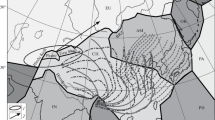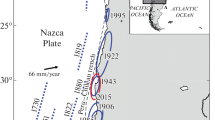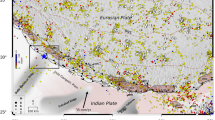Abstract
In this paper, we explore the Western Pacific subduction impact on the geodynamics of the Asian continent. The data on migration of slow strain and earthquakes from the Nankai, Japan and Kuril-Kamchatka segments of the Western Pacific subduction zone deep into mainland Asia are analyzed. The calculations performed on five profiles, crossing the Kuril Islands, the Japanese Archipelago and Sakhalin Island toward the Asian continent, have revealed the transverse migration of earthquakes from the Japan–Kuril-Kamchatka subduction zone. The velocities of hypocenter migration of M ≥ 4.5 earthquakes from the Kuril-Kamchatka Trench via northern and central Sakhalin vary from 6 to 17 km/year, on average, at different depths. The profiles crossing the islands of Hokkaido and Sakhalin show the M ≥ 4.earthquake migration from the Kuril and Japan trenches at velocities of 8–27 km/year.






Similar content being viewed by others
References
Anderson, D. L. (1975). Accelerated plate tectonics. Science, 187, 1077–1079.
Baranov, B. V., Vikulin, A. V., & Lobkovsky, L. I. (1989). Shallow-focus seismicity in the rear of the Kuril island arc and its relationship with the largest earthquakes in the underthrusting zone. Vulkanologiya i Seismologiya, 6, 73–84. In Russian.
Bott, M. H. P., & Dean, D. S. (1973). Stress diffusion from plate boundaries. Nature, 243(5406), 339–341.
Bykov, V. G. (2014). Sine-Gordon equation and its application to tectonic stress transfer. Journal of Seismology, 18(3), 497–510.
Bykov, V. G., & Merkulova, T. V. (2020). Earthquake migration and hidden faults in the Priamurye Region. Russian Journal of Pacific Geology, 14(4), 326–339.
Bykov, V. G., & Trofimenko, S. V. (2016). Slow strain waves in blocky geological media from GPS and seismological observations on the Amurian plate. Nonlinear Processes in Geophysics, 23(6), 467–475.
Dragoni, M., Bonafede, M., & Boschi, E. (1982). Stress relaxation in the earth and seismic activity. Rivista Del Nuovo Cimento, 5(2), 1–34.
Earthquakes in Northern Eurasia 2005. (2011). Obninsk: GS RAS. p 492. (In Russian).
Earthquakes of Russia in 2004. (2007). Obninsk: GS RAS. p. 140. (In Russian).
Elsasser, W. M. (1969). Convection and stress propagation in the upper mantle. In S. K. Runcorn (Ed.), The Application of Modern Physics to the Earth and Planetary Interiors (pp. 223–246). N.Y.: Willey.
Harada, M., Furuzawa, T., Teraishi, M., & Ohya, F. (2003). Temporal and spatial correlations of the strain field in tectonic active region, southern Kyusyu, Japan. Journal of Geodynamics, 35(4–5), 471–481.
Hirose, F., Maeda, K., & Yoshida, Y. (2019). Maximum magnitude of subduction earthquakes along the Japan–Kuril-Kamchatka trench estimated from seismic moment conservation. Geophysical Journal International, 219, 1590–1612.
Ishii, H., Sato, T., Tachibana, K., Hashimoto, K., Murakami, E., Mishina, M., Miura, S., Sato, K., & Takagi, A. (1983). Crustal strain, crustal stress and microearthquake activity in the northeastern Japan arc. Tectonophysics, 97(1–4), 217–230.
Ishii, H., Sato, T., & Takagi, A. (1978). Characteristics of strain migration in the northeastern Japanese Arc (I)—Propagation characteristics. Science Reports of the Tohoku University Series 5 Geophysics, 25(2), 83–90.
Ishii, H., Sato, T., & Takagi, A. (1980). Characteristics of strain migration in the northeastern Japanese arc (II)—Amplitude characteristics. Journal of the Geodemic Society of Japan, 26(1), 17–25.
Ito, T., & Hashimoto, M. (2001). Migrating crustal deformation from GEONET observations. Eos, Transactions of the American Geophysical Union, 82(47), F265–F265. Abstract G31A–0122.
Kasahara, K. (1973). Earthquake fault studies in Japan. Philosophical Transactions of the Royal Society, A, 274, 287–296.
Kasahara, K. (1979). Migration of crustal deformation. Tectonophysics, 52(1–4), 329–341.
Kuznetsov, I. V., & Keilis-Borok, V. I. (1997). The interrelation of earthquakes of the Pacific seismic belt. Doklady Akadeii Nauk, 355(3), 389–393. In Russian.
Lehner, F. K., Li, V. C., & Rice, R. (1981). Stress diffusion along rupturing boundaries. Journal of Geophysical Research, 86(B7), 6155–6169.
Liu, M., Stein, S., & Wang, H. (2011). 2000 years of migrating earthquakes in North China: How earthquakes in midcontinents differ from those at plate boundaries. Lithosphere, 3, 128–132.
Mino, K. (1988). Migration of great earthquake along the subduction zone of Japan Archipelago. Journal of the Seismological Society of Japan, 41(3), 375–380.
Miura, S., Ishii, H., & Takagi, A. (1989). Migration of vertical deformations and coupling of island arc plate and subducting plate. In S. C. Cohen & P. Vanííek (Eds.), Slow deformation and transmission of stress in the earth, Geophysical monograph series (Vol. 49, pp. 125–138). American Geophysical Union.
Mogi, K. (1968). Migration of seismic activity. Bulletin of the Earthquake Research Institute, University of Tokyo, 46, 53–74.
Mogi, K. (1973). Relationship between shallow and deep seismicity in the western Pacific region. Tectonophysics, 17(1–2), 1–22.
Molchanov, O. A. (2011). Underlying mechanism of precursory activity from analysis of upward earthquake migration. Natural Hazards and Earth System Science, 11, 135–143.
Molchanov, O. A., & Uyeda, S. (2009). Upward migration of earthquake hypocenters in Japan, Kurile-Kamchatka and Sunda subduction zones. Physics and Chemistry of the Earth, 34(6–7), 423–430.
Novopashina, A. V., & Lukhneva, O. F. (2020). Methodical approach to isolation of seismic activity migration episodes of the northeastern Baikal rift system (Russia). Episodes, 43(4), 947–959.
Novopashina, A. V., & San’kov, V. A. (2018). Migrations of seismic energy released in various geodynamic conditions. Geodynamics and Tectonophysic, 9(1), 139–163. In Russian.
Pollitz, F. F., Bürgmann, R., & Romanowicz, B. (1998). Viscosity of oceanic asthenosphere inferred from remote triggering of earthquakes. Science, 280(5367), 1245–1249.
Press, F., & Allen, C. (1995). Patterns of seismic release in the southern California region. Journal of Geophysical Research, 100(4), 6421–6430.
Rice, J. R. (1980). The mechanics of earthquake rupture. In A. M. Dziewonski & E. Boschi (Eds.), Physics of the Earth’s interior (pp. 555–649). Italian Physical Society.
Ruzhich, V. V., Kochyaryan, G. G., & Levina, E. A. (2016). Estimated geodynamic impact from zones of collision and subduction on the seismotectonic regime in the Baikal Rift. Geodynamics and Tectonophysics, 7(3), 383–406. In Russian.
Rydelek, P. A., & Sacks, I. S. (1988). Asthenospheric viscosity inferred from correlated land-sea earthquakes in northeast Japan. Nature, 336, 234–237.
Saprygin, S. M., Vasilenko, N. F., & Soloviev, V. N. (1997). Propagation of the wave of tectonic stresses through the Eurasian plate in 1978–1983. Geologiya i Geofizika, 38(3), 701–709. In Russian.
Seno, T. (1979). Pattern of intraplate seismicity in southwest Japan before and after great interplate earthquakes. Tectonophysics, 57, 267–283.
Sherman, S. I. (2013). Deformation waves as a trigger mechanism of seismic activity in seismic zones of the continental lithosphere. Geodynamics and Tectonophysics, 4(2), 83–117. In Russian.
Stepashko, A. A. (2010). Deep roots of seismotectonics in the Far East. The Sakhalin zone. Russian Journal of Pacific Geology, 4(3), 228–241.
Stepashko, A. A. (2011a). Deep roots of seismotectonics in the Far East. The Amur River and Primorye zones. Russian Journal of Pacific Geology, 5(1), 1–12.
Stepashko, A. A. (2011b). Seismodynamics and deep internal origin of the North China zone of strong earthquakes. Geodynamics and Tectonophysics, 2(4), 341–355. In Russian.
Stepashko, A. A., & Merkulova, T. V. (2017). Deep structure, genesis and seismic activation of the Bureya Orogen, Russian Far East. Russian Journal of Pacific Geology, 11, 237–250.
Takahashi, K., & Seno, T. (2005). Diffusion of crustal deformation from disturbances arising at plate boundaries—A case of the detachment beneath the Izu Peninsula, central Honshu, Japan. Earth, Planets and Space, 57, 935–941.
Trofimenko, S. V., Bykov, V. G., & Merkulova, T. V. (2017). Space-time model for migration of weak earthquakes along the northern boundary of the Amurian microplate. Journal of Seismology, 21(2), 277–286.
Vikulin, A. V. (1992). The largest earthquake foci migration in Kamchatka and the Northern Kuriles and their recurrence interval. Vulkanologiya i Seismologiya, 1, 46–61. In Russian.
Vikulin, A. V., Akmanova, D. R., Osipova, N. A., Chebanyuk, S. V., Mikhalina, AYu., Sumakova, E. I., & Yakimova, E. V. (2009). Recurrence of large earthquakes and their foci migration along the seismic belt. Vestnik of Kamchatkan State Technical University, 10, 17–25. In Russian.
Vil’kovich, E. V., & Shnirman, M. G. (1982). Waves of epicenter migration (examples and models). Vychislitel’naya Seismologiya, 14, 27–37. In Russian.
Yoshida, A. (1988). Migration of seismic activity along interplate seismic belts in the Japanese Islands. Tectonophysics, 145(1–2), 87–99.
Žalohar, J. (2018). The omega-theory: A news physics of earthquakes (p. 558). Publishing House Elsevier.
Žalohar, J., Vičič, B., Potočnik, M., Soklič, N., Komac, M., Hölscher, T., Herlec, U., & Dolenec, M. (2020). Precursory stress changes before large earthquakes; on a new physical law for earthquakes. Journal of Structural Geology, 141, 104–208.
Zhao, G., & Yao, L. (1995). Earthquake migration in East Asia mainland (I)—The migration of huge earthquakes and volcanic activity from West Pacific trench to the Chinese mainland. Acta Seismologica Sinica, 8(4), 541–549.
Zhao, G., & Yao, L. (1997). Earthquake migration in East Asia mainland (2)—Migration along seismic zones. South China Journal of Seismology, 17(1), 15–24. In Chinese with English abstract.
Acknowledgements
The authors thank the Guest Editors, Alexander Soloviev, D.Sci., Vladimir Kossobokov, D.Sci., and two anonymous reviewers for all the comments, which contributed to improving the manuscript.
Funding
The study was performed within the framework of the State Assignment for the Kosygin Institute of Tectonics and Geophysics, Far East Branch, Russian Academy of Sciences (AAAA-A18-118020790043-9).
Author information
Authors and Affiliations
Corresponding author
Ethics declarations
Conflict of interest
The authors declare that they have no conflict of interest.
Additional information
Publisher's Note
Springer Nature remains neutral with regard to jurisdictional claims in published maps and institutional affiliations.
Rights and permissions
About this article
Cite this article
Bykov, V.G., Merkulova, T.V. & Andreeva, M.Y. Stress Transfer and Migration of Earthquakes from the Western Pacific Subduction Zone Toward the Asian Continent. Pure Appl. Geophys. 179, 3931–3944 (2022). https://doi.org/10.1007/s00024-021-02924-7
Received:
Revised:
Accepted:
Published:
Issue Date:
DOI: https://doi.org/10.1007/s00024-021-02924-7




